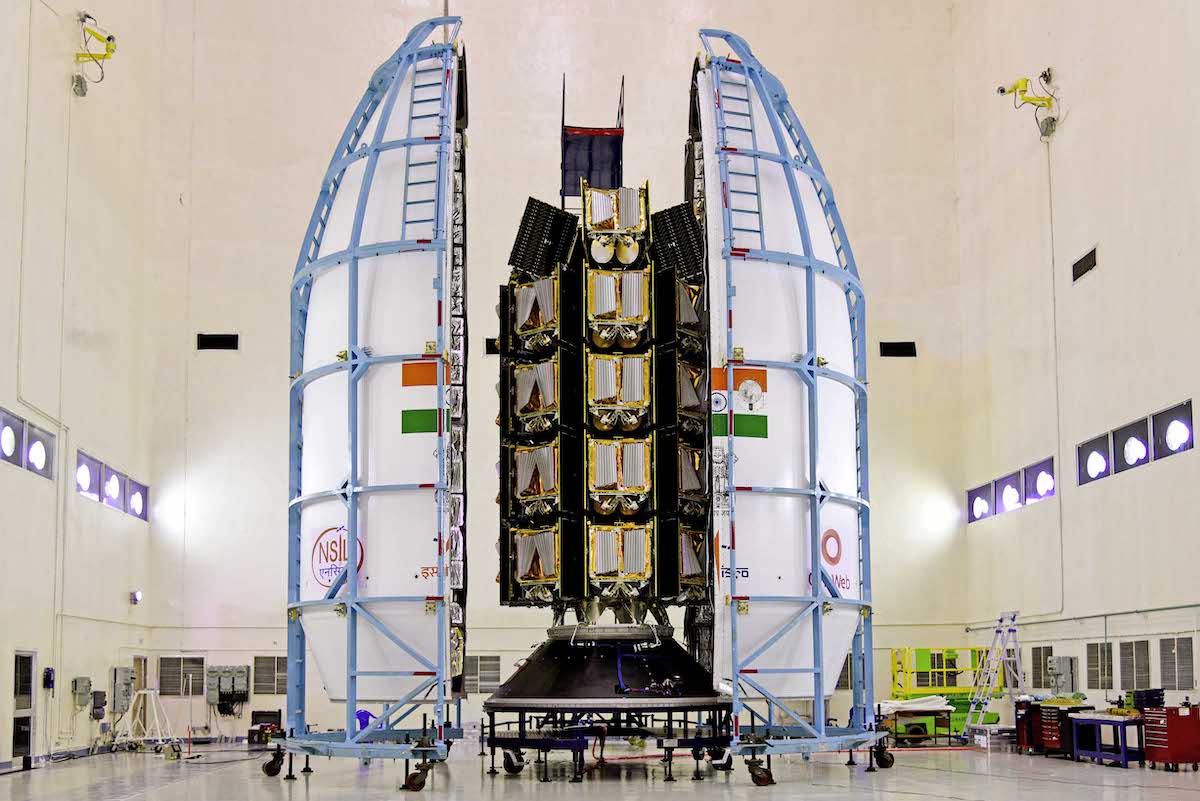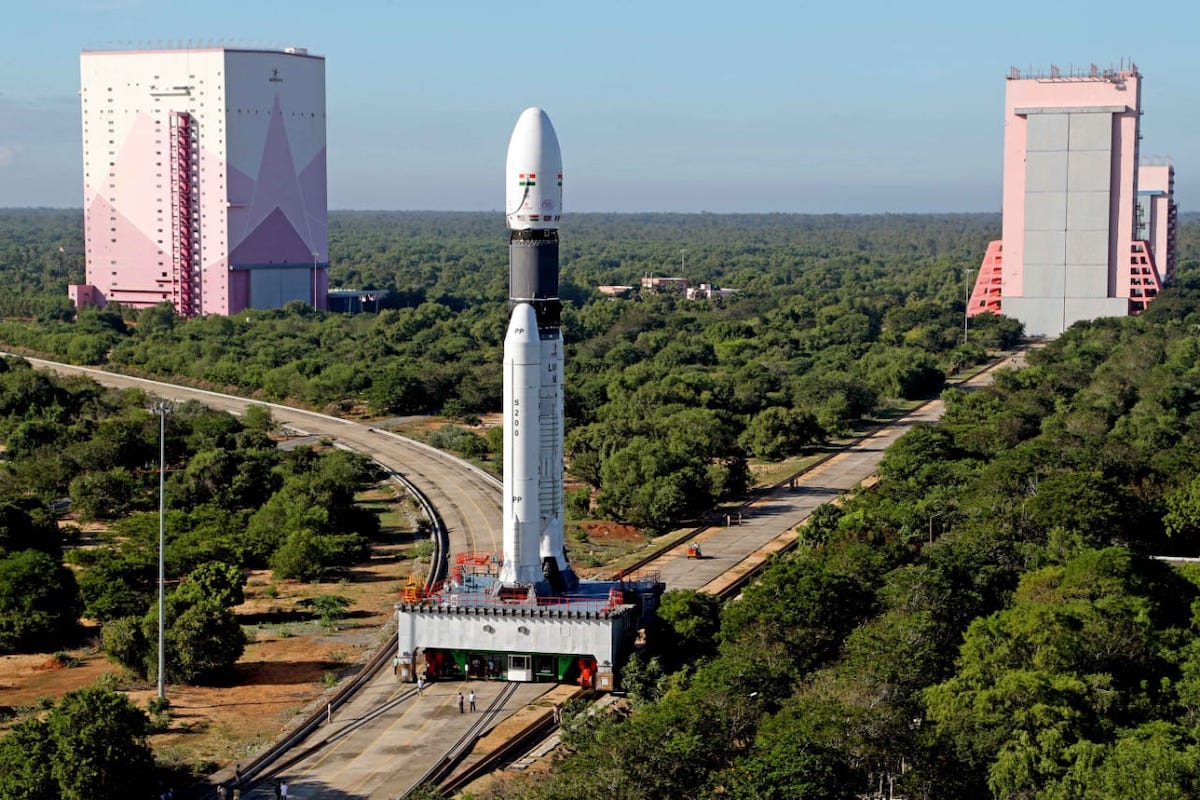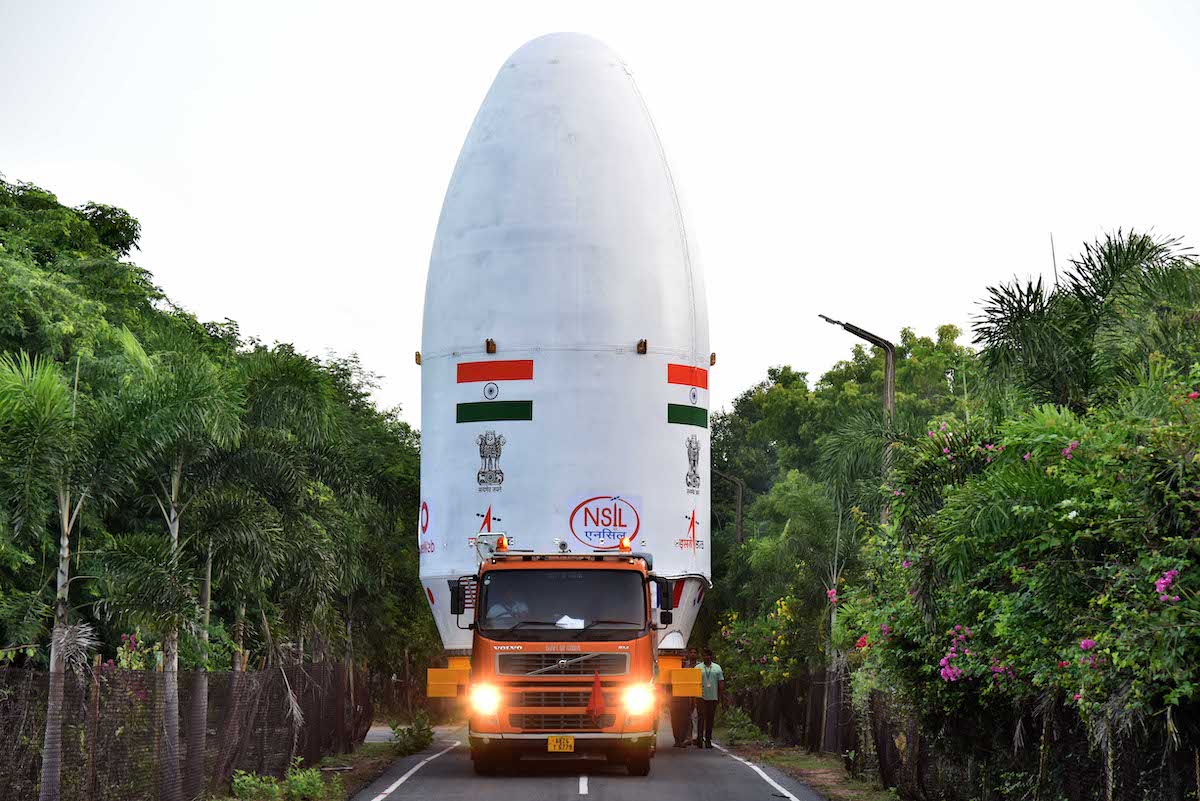
After the suspension of commercial launches on Russia’s Soyuz rocket earlier this year, OneWeb is set to resume deploying satellites for its global internet network Saturday with an Indian GSLV Mk.3 launcher, one of five OneWeb missions planned before mid-2023 to finish the company’s first-generation constellation.
There are 36 OneWeb satellites attached to the top of India’s Geosynchronous Satellite Launch Vehicle Mk.3, or GSLV Mk.3, awaiting liftoff at 2:37 p.m. EDT (1837 GMT) Saturday from the Satish Dhawan Space Center, located on Sriharikota Island on India’s east coast. Launch is scheduled for 12:07 a.m. Sunday local time in India.
The GSLV Mk.3, also called the LVM3, is India’s most powerful rocket, propelled by two large side-mounted solid rocket boosters producing 2.2 million pounds of thrust, a core stage with two hydrazine-fueled Vikas engines, and a cryogenic upper stage with a hydrogen-burning engine.
The 143-foot-tall (43.5-meter) rocket will aim to release the 36 OneWeb satellites into a 373-mile-high (601-kilometer) polar orbit. Each OneWeb satellite will deploy solar panels and use ion engines to reach their operating altitude of 745 miles (1,200 kilometers).
OneWeb’s satellites are designed to beam low-latency broadband internet signals to customers around the world. The London-based company is one of several operators either already launching large fleets of internet satellites, or planning to begin launches soon.
SpaceX has launched more than 3,500 Starlink internet satellites using the company’s own reusable Falcon 9 rocket. OneWeb has launched 428 satellites of a planned first-generation constellation of 648 spacecraft using 13 Russian Soyuz rockets purchased through Arianespace, the French launch services provider. And Amazon plans to launch its first two prototype internet satellites of a planned constellation of 3,236 spacecraft next year on the first flight of United Launch Alliance’s new Vulcan rocket.
But OneWeb’s launch plans were interrupted earlier this year after Russia’s invasion of Ukraine.
Arianespace was on the hook with OneWeb for six more Soyuz launches from the Baikonur Cosmodrome in Kazakhstan, including a 14th launch that was set to take off in March. But Russia’s space agency set conditions on the mission after rolling the rocket and the OneWeb satellites to a launch pad at Baikonur, including a demand that the UK government give up its stake in OneWeb.
The UK government declined, and OneWeb announced March 3 it was suspending launches from Baikonur. OneWeb reported a loss of $229.2 million on its financial statements as a result of the termination of the planned Soyuz launch in March. The financial charge also covers losses associated with the postponement of subsequent Soyuz missions, and the loss of 36 satellites stranded in Kazakhstan and not returned to OneWeb by Russia, which runs the Baikonur Cosmodrome.
Less than a month after Soyuz launches were suspended, OneWeb announced an agreement with SpaceX to launch some of its remaining satellites. OneWeb finalized a similar agreement with New Space India Limited, the commercial arm of India’s space agency, for launches on Indian rockets.
The contract with SpaceX was surprising to many satellite industry watchers because OneWeb is an indirect competitor in broadband market. SpaceX sells Starlink service directly to consumers, while OneWeb sells to enterprises and internet service providers to provide connectivity for entire businesses or communities.
There are three Falcon 9 flights planned for OneWeb into polar orbit from Cape Canaveral — a short drive from OneWeb’s factory on Florida’s Space Coast — later this year and early next year. OneWeb has procured two launches on India’s GSLV Mk.3 rocket, the first of which is set to blast off Saturday.
OneWeb said earlier this year the three Falcon 9 flights will be equivalent to the launch capacity of four Soyuz rockets, which carried as many as 36 OneWeb satellites on each flight. That would mean SpaceX will launch around 48 OneWeb spacecraft on each mission, although the exact figures haven’t been confirmed.
The five additional launches should be complete in the first half of next year, with all the satellites entering commercial service by the end of 2023, according to OneWeb.

Despite the pause in launches, production of OneWeb satellites continued at a factory near NASA’s Kennedy Space Center. The satellites are built by a joint venture between Airbus and OneWeb.
OneWeb shipped 36 satellites from Florida to India last month for the company’s first launch on the GSLV Mk.3.
The 36 OneWeb spacecraft rode to the launch site on a Ukrainian Antonov An-124 cargo aircraft. Antonov airplanes have been widely used for transporting satellites between their factories and launch sites around the world, but have seen less use this year after Russian-owned aircraft — as most active An-124s are — were banned from U.S. and European airspace in the wake of Russia’s attack on Ukraine.
The Antonov An-124 used for the OneWeb transport last month was a Ukrainian-owned aircraft.
Technicians at the Satish Dhawan Space Center attached the 36 OneWeb satellites — each weighing about 325 pounds (147.5 kilograms) — to a Swedish-built dispenser provided by Beyond Gravity, formerly known as RUAG Space. The same type of deployer was used on the Soyuz launches for OneWeb.
Once the satellites were mounted to the deployment fixture, the entire structure was encapsulated by the Indian rocket’s payload fairing. Then ground teams drove the payload compartment to the GSLV Mk.3 integration hangar for stacking on top of the rocket, which was already assembled inside the building.
On Oct. 15, Indian engineers transferred the fully-stacked rocket to the Second Launch Pad at the spaceport for final liftoff preparations.
The final steps before launch will include filling the rocket’s core stage with hydrazine and nitrogen tetroxide propellants, and loading super-cold liquid hydrogen and liquid oxygen into the cryogenic upper stage.
The GSLV Mk.3 rocket will ignite two 86-foot-long (26.2-meter) S200 solid rocket boosters to climb off the pad. A core stage driven by two Vikas engines will ignite at T+plus 1 minute, 46 seconds, followed by burnout and separation of the strap-on boosters at T+plus 2 minutes, 10 seconds, after they each burn through their supply of more than 225 tons (205 metric tons) of pre-packed solid propellants.
The twin Vikas engines will fire until T+plus 5 minutes, 3 seconds, each producing around 190,000 pounds of thrust. The liquid-fueled powerplants are new higher-thrust variants of the Vikas engine that debuted in 2018.
The GSLV Mk.3’s upper stage engine will ignite at T+plus 5 minutes, 5 seconds, moments after separation of the core stage. The upper stage engine burned until T+plus 15 minutes, 45 seconds, to place the 36 OneWeb satellites into orbit.
The OneWeb satellites will begin separating from their dispenser on the GSLV’s upper stage at T+plus 19 minutes, 45 seconds. The spacecraft will deploy in groups of four over the following 90 minutes.

OneWeb kept busy developing and testing ground systems and user terminals during the break in launches.
Eutelsat and OneWeb also announced plans to merge in July, bringing together OneWeb’s network of internet satellites in low Earth orbit with Eutelsat’s fleet of larger video, data relay, and broadband platforms in geostationary orbit.
The switch in launch vehicles for OneWeb’s remaining deployment missions was not the first hurdle the company has overcome. OneWeb weathered bankruptcy in 2020, and emerged under the majority ownership of Bharti Global, an Indian telecom company, and the UK government.
Founded by entrepreneur Greg Wyler in 2012, OneWeb is already planning an even larger constellation called Gen 2 that the company says could be ready for commercial service by early 2028. Pending the conclusion of the merger, Eutelsat’s resources will help OneWeb finance its Gen 2 constellation. OneWeb’s other current shareholders include Bharti, the UK government, and the Japanese company Softbank, among others.
OneWeb signed a settlement agreement with Arianespace earlier this year after the suspension of Soyuz launches. The terms of the settlement are confidential, Arianespace said, but could allow Arianespace to resume launches for OneWeb in the future on Europe’s new Ariane 6 rocket for the second generation of the OneWeb constellation.
OneWeb also announced an agreement with Relativity Space in June for multiple Gen 2 satellite launches beginning as soon as 2025 on the launch company’s next-generation reusable Terran R rocket.
Email the author.
Follow Stephen Clark on Twitter: @StephenClark1.
